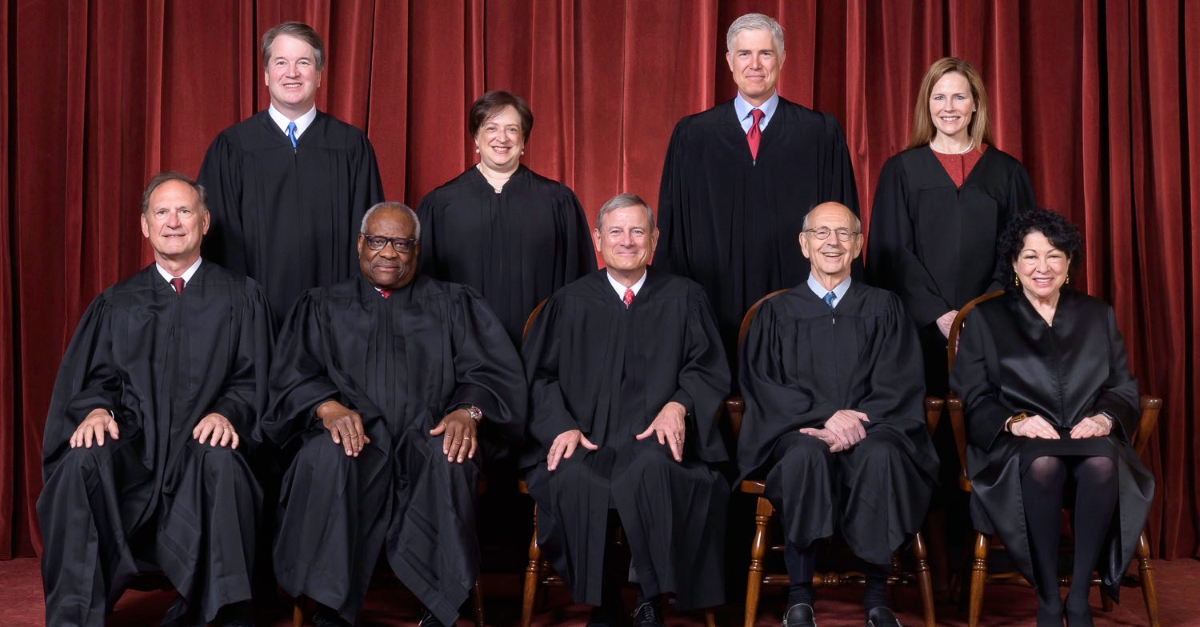
Seated from left to right: Justices Samuel A. Alito, Jr. and Clarence Thomas, Chief Justice John G. Roberts, Jr., and Justices Stephen G. Breyer and Sonia Sotomayor.
Standing from left to right: Justices Brett M. Kavanaugh, Elena Kagan, Neil M. Gorsuch, and Amy Coney Barrett.
ABA Legal Fact Check debuted in August 2017 and is the first fact check website focusing exclusively on legal matters. This article has been republished with permission.
In his U.S. Senate confirmation hearings 17 years ago, U.S. Supreme Court Chief Justice John Roberts was pressed on his view of the doctrine of stare decisis. “I do think it is a jolt to the legal system when you overrule a precedent,” he said. “Precedent plays an important role in promoting stability and evenhandedness.”
With the spring 2022 leaked draft opinion in Dobbs v. Jackson Women’s Health Organization that would overturn the Supreme Court’s landmark 1973 abortion decision in Roe v. Wade, the concept of stare decisis, a Latin term which means “to stand by things decided,” has moved from legal jargon to everyday conversations. But is the U.S. Supreme Court bound by the concept? And is overturning legal precedents that rare?
The concept of stare decisis, commonly known as legal precedent, is ingrained in the U.S. system of justice and stands out as a bedrock of the rule of law. The U.S. Supreme Court has often stated that following its prior decisions encourages stability, brings uniformity in the application of law to cases and litigants, and establishes a societal reliance on settled law. Former Associate Justice Lewis Powell once remarked: “The elimination of constitutional stare decisis would represent an explicit endorsement of the idea that the Constitution is nothing more than what five justices say it is.”
The actual concept is not found in the U.S. Constitution nor in any statute. The concept is rooted in English common law, and Alexander Hamilton in Federalist Paper 78 said, “To avoid an arbitrary discretion in the judges, they need to be bound down by rules and precedents…(and) the records of those precedents must unavoidably swell to a very considerable bulk.”
In practice, the doctrine operates both horizontally and vertically. Judicial hierarchy compels lower courts to follow precedent from a higher court, regardless of a judge’s personal persuasion, wisdom or rationality. To a lower court judge, Supreme Court decisions are the law. Horizontal precedent refers to the nation’s highest court adhering to its own precedents. Most states follow the federal model for both.
Over the years, Supreme Court justices have embraced the concept with varying degrees of fidelity. Former Chief Justice William Rehnquist said in a 1991 decision that precedent “is a principle of policy and not a mechanical formula of adherence to the latest decision.” In his confirmation hearings, current Associate Justice Samuel Alito, who penned the draft opinion that would overturn Roe v. Wade, brushed aside any suggestion of an established precedent, or super-precedent, that would survive the test of time and could not be changed. “I personally would not get into categorizing precedents as super-precedents or super-duper precedents,” Alito testified.
A 5-4 decision in 2019 upset decades of precedent that barred property owners from going to federal court until their claims had been denied in state court and caused Associate Justice Elena Kagan to register a strongly worded dissent. “Judges do not get to reverse a decision just because they never liked it in the first instance,” she said, adding that “it is hard to overstate the value, in a country like ours, of stability in law.”
A 2018 report from the Congressional Research Service (CRS) found that the U.S. Supreme Court has overruled its prior decisions 141 times, or less than one a year since the first reversal in 1851, including seven times in 1976 alone. Since the CRS report was issued, a handful of other decisions have been overturned.
“The Supreme Court applies the doctrine of stare decisis by following the rules of its prior decisions unless there is a ‘special justification’ — or, at least, ‘strong grounds’ — to overrule precedent,” the CRS report said. “In adopting this approach, the court has rejected a more formalistic view of stare decisis that would require it to adhere to its prior decisions regardless of the merits of those decisions or the practical implications of retaining or discarding precedent.”
Legal scholars explain that precedent helps to make sense out of the tensions between the wisdom of the past and the rationality of the present. And history is punctuated by examples.
In 1954, the court by a 9-0 vote in Brown v. Board of Education struck down the 1896 decision in Plessy v. Ferguson, which allowed for separate but equal treatment along racial lines. The decision launched a revolution of sorts related to integration and civil rights law that continues today.
Of the few precedents set aside, many are overturned within a few years or within a generation. In 2003, the court decided Texas v. Lawrence, overturning Bowers v. Hardwick,which allowed states to criminalize sodomy. The court simply said that the Bowers decision 17 years earlier “was not correct when it was decided, is not correct today and is hereby overruled.” Many other decisions overruling precedent are more narrow or obscure, whether they deal with common law or interpretations of statutes or federal or state constitutions.
In his leaked draft opinion, Justice Alito specifically states that stare decisis “does not compel unending adherence to Roe’s abuse of judicial authority.” Lower court rulings, of course, are frequently overturned if they don’t follow precedent. But because the U.S. Supreme Court has, in theory, the last word on deciding cases, the only judicial review of its decisions is by a future court.
Read more of ABA’s Legal Fact Check series here.
[Image via Supreme Court of the United States]